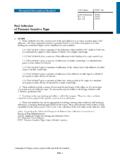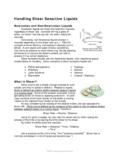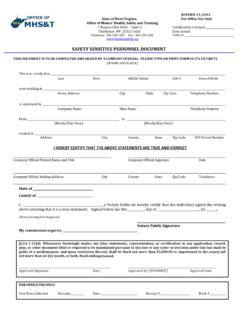Transcription of TEMPERATURE-SENSITIVE PACKAGING WITH DRY ICE AND ...
1 Manufacturing/Distribution Centers in Illinois and Pennsylvania Temperature Safe Shipping & Protective PACKAGING Products TEMPERATURE-SENSITIVE PACKAGING with . DRY ICE AND REFRIGERANT PACKS. INTRODUCTION. Fundamental Guidelines on PACKAGING Perishable Products You can count on Polar Tech Industries to truly understand the importance of protecting your perishable shipments. Temperature- sensitive PACKAGING products and services are our business. We are dedicated to manufacturing high-quality products, providing free professional consulting solutions and developing new and improved products and services to meet your needs. This is our responsibility. The condition of your shipment when it arrives at its destination depends on how you package it. This is your responsibility. Because perishable products may be subjected to extreme heat or cold, rough handling, vibration and aircraft pressures during shipment, they must be properly packaged to prevent spoilage and maintain product integrity.
2 This Technical Section will assist you in preparing your perishable shipments for small-parcel, express and multi-day shipping environments. If you have any questions, need advice or would like to take advantage of our services, call our PACKAGING consultants at 1-800-423-2749. FREQUENTLY ASKED QUESTIONS. Where do I begin? When determining how to package your perishable products, you should take several factors into consideration. The three most important factors are: insulation, refrigerants and protective PACKAGING . INSULATION. Insulation is any material that prevents or reduces the transfer of heat. The unit of measure for insulation properties is thermal conductivity, or K-factor. The lower the K-factor, the better the insulation. R-value is sometimes used to define the resistance of heat transfer. R-value is the reciprocal (1/K) of K-factor. The higher the R-value, the better the insulation.
3 The purpose of insulation is to maintain products within a desired temperature range. Insulation may be used to keep products refrigerated, frozen or warm, or to reduce the effects of extreme temperature variations. Common insulation materials include: Expanded Polystyrene Foam (EPS). Rigid High-Density Polyurethane (spray-in-place foam). Reflecting Surface Material (radiant barrier films). Some products that typically need insulation are: chemicals, pharmaceuticals, medical specimens, blood, seafood, dairy products, bakery products, meat, chocolates, live lobsters, plants and sensitive instruments. REFRIGERANTS. Refrigerants are products designed to control the internal temperature of a package. Refrigerants typically can maintain only three temperature ranges: frozen, refrigerated and warm. The temperature requirements of your perishable product will determine the type of refrigerant you need to use.
4 Common types of refrigerants are: Refrigerant Packs (Gel, Foam to maintain product temperature). Wet Ice (to keep products refrigerated). Dry Ice (to keep products frozen). PROTECTIVE PACKAGING . It is important to keep in mind that, beyond providing thermal protection, you must also provide protection for the handling your package receives during shipment. Protective PACKAGING includes internal and external PACKAGING products needed to guard against the elements, rough handling, shock, vibration, compression and aircraft pressures. Common protective PACKAGING materials include: Expanded Polystyrene Foam (EPS). Corrugated Fiber Board Boxes Packing Peanuts Bubble Wrap Wadding Absorbent Materials Plastic Bags Plastic Thermal Formed Internal Foam or Corrugated Partitions Certain products require more protective PACKAGING , for example, glass containers, biohazards, liquids, delicate instruments, dry ice, wet ice, chemicals and blood.
5 What types of insulated containers are available? Expanded Polystyrene Foam (EPS) - molded containers or paneled foam sheets maintain allowable temperature ranges from controlled, to refrigerated to frozen. EPS is the most common material used for insulated containers because of its effectiveness, low cost and ease of recycling. Rigid High-Density Polyurethane Foam (Spray-in-place foam) Chest and lid or panel insulated containers also maintain allowable temperature ranges from controlled, to refrigerated to frozen. The advantage of polyurethane foam is that it has a slightly higher R-value than EPS foam. Spray-in-place polyurethane foam is a good choice for extreme shipping durations, such as international ship- ments, in which an item may be delayed in customs. The disadvantages are that it is two to three times more expensive than EPS and that it cannot be recycled.
6 What's more, every year and increasing number of foreign countries ban rigid high-density polyurethane containers because of environmental issues. Most countries now require the shipper to return the container to its country of origin. Which insulated container will fit my product? First, measure your product by length, by width and by height. Then, after allowing for some additional space for refrigerant packs and/or wet or dry ice, choose an insulated container with inside dimensions a little larger than your product. Keep in mind that the ideal location for refrigerants in PACKAGING is above and around your product. Next, determine the required wall thickness of the insulated shipper by considering the temperature requirements of your product and its shipping duration. An EPS foam container with 3/4 to 1 wall thickness and a - density is sufficient for 1 - 2 day shipping.
7 11/4 to 11/2 wall thickness should be used for 2-5 day shipping. For extended shipping time, a thicker EPS foam container (2 - 3 ) may be necessary. EPS foam containers with a 2 - 3 wall thickness provides insulation similar to that of a rigid high-density polyurethane container. For a correct fit for your product and applications, we will be happy to help. Call our PACKAGING specialists at 1-800-423-2749. How many gel refrigerants should I use? Refrigerants keep perishable products cold or frozen. Frozen refrigerants should be placed around products to absorb the heat that may enter from any direction. Size is generally determined by the size and weight of the product. This is just a general guideline . more or fewer refrigerants may be needed depending on the season, destination and the duration of the shipment. It is recommended that your company conduct tests to determine the proper amount of refrigerant to meet your particular shipping requirements.
8 Leakproof gel refrigerants are the Refrigerants of Choice among most express carriers. However, aircraft pressures may affect seals on the lesser quality style gel refrigerants causing them to explode, thereby contaminating or damaging your perishable product. Use caution when selecting gel refrigerants to avoid damaged shipments. Are there any differences between ice packs? Yes, When evaluating ice packs, you should consider serveral things. Examine the following: the thickness of the poly pouch material, the quality of the seal and the consistency of the gel. The thicker the poly, the more resistant it will be to tears. All ice packs are sus- ceptible to being punctured or torn when handled. If the texture of the gel feels similar to syrup, once a tear develops it is likely to leak onto your product and may contaminate your shipment. A thicker consistency or one-piece gel provides extra protection from leakage as well as longer temperature retention because of its mass.
9 Can I use wet ice with my product? The use of wet ice in perishable shipments must be approved in advance by the carrier of your choice. Wet ice has many disadvantages, including its weight, tendency to thaw or leak and the need for expensive water resistant PACKAGING . Contact your carrier for more information. How much dry ice should I use? The amount of dry ice needed to keep products frozen for a desired length of time depends on three main factors: the product mass, the inside dimensions of the insulated container and its wall thickness. The temperature of dry ice is approximately - 800 F. Contact your carrier for any restrictions imposed on the use of dry ice and for more information. General Guidelines for the sublimation of dry ice: First 24 hours 4-6 pounds of dry ice per 1,000 cubic inches*. Second 24 hours 3-5 pounds of dry ice per 1,000 cubic inches Third 24 hours 2-4 pounds of dry ice per 1,000 cubic inches *1,000 cu.
10 In. is equivalent to a container with inside dimensions of 10 x 10 x 10 . Dry ice blocks or pellets should be packaged in corrugated containers, paper bags or Shipper's Declaration not Required. Airwaybills/airbills must have the following: Part B is required Dry Ice amount must be in Kilograms Note: lb = 1 kg wrapping paper in order to slow the rate at which dry ice sublimates. Depending on the season, destination and duration of your shipment and its temperature requirements, more or less dry ice may be needed. Your company should conduct tests to determine the proper amount of dry ice to meet your specific shipping needs. NOTE: All carriers require that dry ice shipments, including those within the , comply with and/or Department of Transportation regulations. Please DRY ICE, UN1845. kg. Shipper's Name and Address 9 Consignee Name and Address consult your carrier. See the dry ice label located on this page.







